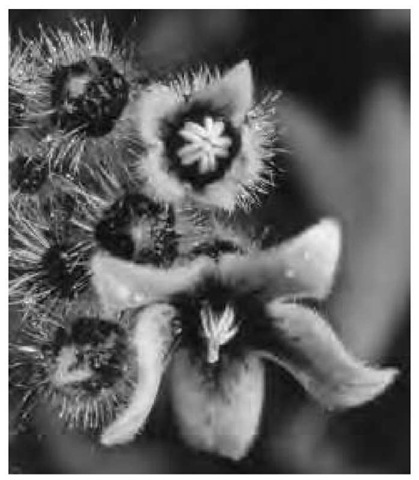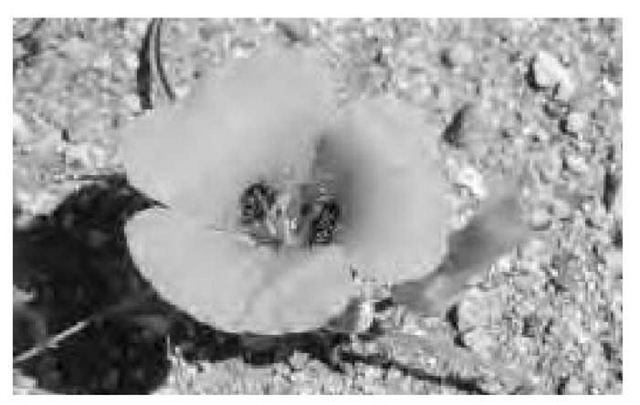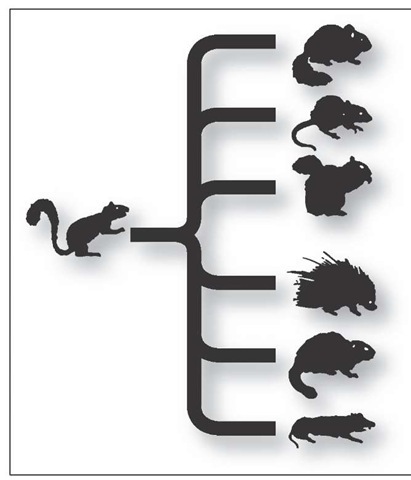ABO blood groups Blood group antibodies (A, B, AB, O) that may destroy red blood cells bearing the antigen to which they are directed; also called "agglutinins." These red-cell antigens are the phenotypic expression of inherited genes, and the frequency of the four main groups varies in populations throughout the world. The antigens of the ABO system are an integral part of the red-cell membrane as well as all cells throughout the body and are the most important in transfusion practice.
abortion The termination of gestation before the fetus can survive on its own.
Abscisic acid (ABA) A plant hormone (C15H20O4) and weak acid that generally acts to inhibit growth, induces dormancy, and helps the plant tolerate stressful conditions by closing stomata. Abscisic acid was named based on a belief that the hormone caused the abscission (shedding) of leaves from deciduous trees during the fall.
At times when a plant needs to slow down growth and assume a resting (dormant) stage, abscisic acid is produced in the terminal bud, which slows down growth and directs the leaf primordia to develop scales that protect the dormant bud during winter. Because the hormone also inhibits cell division in the vascular cambium, both primary and secondary growth are put on hold during winter.
This hormone also acts as a stress agent that helps a plant deal with adverse conditions. For example, ABA accumulates on leaves and causes stomata to close, reducing the loss of water when a plant begins to wilt.
In 1963, abscisic acid was first identified and characterized by Frederick Addicott and colleagues. In 1965, the chemical structure of ABA was defined, and in 1967, it was formally called abscisic acid.
Absorption spectrum Different pigments absorb light of different wavelengths. For example, chlorophyll effectively absorbs blue and red. The absorption spectrum of a pigment is produced by examining, through the pigment and an instrument called a spectroscope, a continuous spectrum of radiation. The energies removed from the continuous spectrum by the absorbing pigment show up as black lines or bands and can be graphed.
Abyssal zone The portion of the ocean floor below 1,000-2,000 m (3,281-6,561 ft.), where light does not penetrate and where temperatures are cold and pressures are intense. It lies seaward of the continental slope and covers approximately 75 percent of the ocean floor. The temperature does not rise above 4°C. Because oxygen is present, a diverse community of invertebrates and fishes do exist, and some have adapted to harsh environments such as hydrothermal vents of volcanic creation. Food-producing organisms at this depth are chemoautotrophic prokaryotes and not pho-tosynthetic producers.
Acclimatization Acclimatization is the progressive physiological adjustment or adaptation by an organism to a change in an environmental factor, such as temperature, or in conditions that would reduce the amount of oxygen to its cells. This adjustment can take place immediately or over a period of days or weeks. For example, the human body produces more erythrocytes (red blood cells) in response to low partial pressures of oxygen at high altitudes; short-term responses include shivering or sweating in warmblooded animals.
Accommodation The automatic reflex adjustment that allows the focal length of the lens of an eye to change to focus on an object. The lens shape, more convex for near objects and less convex for distant objects, is caused by ciliary muscles acting on the elastic property of the lens.
Acetylcholine (ACh) One of the most common neurotransmitters of the vertebrate nervous system, ACh is a chemical (CH3COOCH2CH2N+(CH3)3) that transmits impulses between the ends of two adjacent nerves or neuromuscular junctions. Released by nerve stimulation (exciting or inhibiting), it is confined largely to the parasympathetic nervous system, where it diffuses across the gap of the synapse and stimulates the adjacent nerve or muscle fiber. It rapidly becomes inactive by the enzyme cholinesterase, allowing further impulses to occur.
Acetyl CoA A compound formed in the mitochondria when the thiol group (-SH) of coenzyme A combines with an acetyl group (CH3CO-). It is important in the Krebs cycle in cellular respiration and plays a role in the synthesis and oxidation of fatty acids.
Fritz Albert Lipmann (1899-1986), a biochemist, is responsible for discovering coenzyme A and cofactor A, or CoA (A stands for acetylation), in 1947. He shared the 1953 Nobel Prize in physiology or medicine with hans krebs.
Acid A chemical capable of donating a hydron (proton, H+) or capable of forming a covalent bond with an electron pair. An acid increases the hydrogen ion concentration in a solution, and it can react with certain metals, such as zinc, to form hydrogen gas. A strong acid is a relatively good conductor of electricity. Examples of strong acids are hydrochloric (muriatic), nitric, sulfuric, while examples of mild acids are sul-furous and acetic (vinegar). The strength of an acidic solution is usually measured in terms of its pH (a logarithmic function of the H+ ion concentration). Strong acid solutions have low pHs (typically around 0-3), while weak acid solutions have pHs in the range 3-6.
Acidity constant The equilibrium constant for splitting off a hydron from a br0nsted acid.
Acid-labile sulfide Refers to sulfide ligands, e.g., the bridging ligands in iron-sulfur proteins, which are released as H2S at acid pH.
Acid precipitation Because pure precipitation (e.g., rain) is slightly acidic (due to the reaction between water droplets and carbon dioxide, creating carbonic acid) with a potential pH of 5.6, acid precipitation refers to precipitation with a pH less than 5.6. Acid precipitation includes rain, fog, snow, and dry deposition. Anthropogenic (man-made) pollutants (carbon dioxide, carbon monoxide, ozone, nitrogen and sulfur oxides, and hydrocarbons) react with water vapor to produce acid precipitation. These pollutants come primarily from burning coal and other fossil fuels. Sulfur dioxide, which reacts readily with water vapor and droplets (i.e., has a short residence time in the atmosphere as a gas), has been linked to the weathering (eating away) of marble structures and the acidification of freshwater lakes (consequently killing fish). Natural interactions within the biosphere can also lead to acid precipitation.
Acoelomate A solid-bodied animal lacking a body cavity, the space between the gut (digestive tract) and body wall. Simple animals do not have a body cavity as higher animals do; this body cavity is called a coelom in mammals and contains the gut (a cavity by itself), heart, and lungs, for example. Acoelomates are bilateral animals and are triploblastic (have three layers: ectoderm, endoderm, and mesoderm). They can move forward and have a degree of cephalization (centralization of neural and sensory organs in the head).
Representative phyla of acoelomates are the Platy-helminthes: flatworms that include the Turbellaria (nonconfined flatworms such as planarians), Monoge-nea (monogeneans), Trematoda (trematodes, or flukes), and Cestoidea (tapeworms). There are more than 20,000 species of flatworms living in wet environments such as marine or freshwater bodies and damp terrestrial areas.
Aconitase A name for citrate (isocitrate) hydro-lyase (aconitate hydratase), which catalyzes the interconver-sion of citrate, cis-aconitate ((Z)-prop-1-ene-1,2,3-tri-carboxylate), and isocitrate. The active enzyme contains a catalytic [4fe-4s] cluster.
Acrosome The acrosome is a special area or compartment that is located at the tip of the head of a sperm cell. It contains special digestive enzymes that on contact with the egg help the sperm head penetrate the egg for fertilization. Directly behind the acrosome is the haploid nucleus (single set of unpaired chromosomes) that contains the genetic material.
The acrosome is a special area or compartment that is located at the tip of the head of a sperm cell.
Mariposa lily from California. An example of an actinomorphic, radially symmetrical flower.
Actin A globular protein found in muscle tissue as thin filaments and in microfilaments that form portions of cell cytoskeletons. Actin links into chains, and paired chains twist helically around each other, forming microfilaments in muscle and other contractile elements in cells. Actin and myosin filaments interact to initiate muscle contraction.
Tropomyosin and troponin are two protein molecules associated with actin filaments in muscle. Tropomyosin runs along the length of the actin filament and covers the area of the actin molecule that interacts with myosin when at rest. On the other hand, when a muscle is contracted, tropomyosin is replaced with troponin as it binds to calcium ions. Troponin is located at regular intervals along the actin filament and allows actin to interact with myosin.
Solanum species as an example of an actinomorphic flower from Sierra Madre Oriental in Mexico.
Actinomorphic Symmetrical over more than one vertical plane; e.g., flowers that can be separated into symmetrical halves along any plane.
Action potential A localized rapid change in voltage that occurs across the membrane of a muscle or nerve cell when a nerve impulse is initiated. It is caused by a physicochemical change in the membrane during the interaction of the flow and exchange of sodium and potassium ions.
Active center The location in an enzyme where the specific reaction takes place.
Active site The active site of an enzyme is the area— a depressed region comprising a few of the protein’s amino acids—on a portion of an enzyme that binds to its substrate. The enzyme’s specificity is based on the shape of the active area, which can alter itself to snugly fit the substrate to which it is binding by using weak chemical bonds.
Active transport The movement of a substance across a biological membrane, such as living cells, against a concentration (diffusion) gradient with the help of metabolic energy, usually provided by ATp (adenosine triphosphate). Active transport serves to maintain the normal balance of ions in cells, in particular ions of sodium and potassium, which play a vital role in nerve and muscle cells. Because a molecule is "pumped" across the membrane against its gradient with the help of metabolic energy, it is referred to as "active" transport.
The sodium-potassium "pump" that exchanges sodium (Na+) for potassium (K+) across the plasma membrane of animal cells is an example of the active transport mechanism.
It is the carriage of a solute across a biological membrane from low to high concentration that requires the expenditure of metabolic energy.
Adaptive radiation The process where a population of plants or animals evolves into a number of different ones over time, usually as a response to multiplying and living under different environmental conditions. Subpopulations from the common ancestor develop as a response to adapting to the new environmental conditions, and new species evolve from this original parent stock.
Impressive rapid adaptive radiations have occurred over time after mass extinctions caused by cataclysmic episodes on the Earth. plate tectonics, vol-canism, and possible Earth-comet-asteroid collisions all have wiped the landscape clean, allowing survivors and new species to rapidly fill the voids of these new adaptive zones.
Address-message concept Refers to compounds in which part of the molecule is required for binding (address) and part for the biological action (message).
Adenosine 5′-triphosphate (ATP) Key nucleotide in energy-dependent cellular reactions, in combination with Mg(II). The reaction: ATP + water ^ ADP + phosphate is used to supply the necessary energy.
Adenylyl cyclase An enzyme, embedded in the plasma membrane, that converts ATP to cyclic adeno-sine monophosphate (cyclic AMP, or cAMP) in response to a chemical signal. It is activated when a signal molecule binds to a membrane receptor. cyclic AMP acts as a second messenger, relaying the signal from the membrane to the metabolic machinery of the cytoplasm.
Adrenal glands A pair of small triangular endocrine glands (one above each kidney in animals) that are ductless and secrete hormones into the blood. The glands are composed of two portions. The adrenal cortex, which forms an outer shell on each and is controlled by the pituitary gland, responds to endocrine signals in reacting to stress and homeostatic conditions by (a) secreting steroid hormones (corticosteroid, cortisol, and aldosterone) that deal with carbohydrate metabolism and with salt and water balance (electrolyte metabolism), such as the reabsorption of water by the kidneys, and (b) releasing androgens (male sex hormone) and estrogens (female sex hormone).
Adaptive radiation is the process where a population of plants or animals evolves into a number of different ones over time, usually as a response to multiplying and living under different environmental conditions.
The adrenal cortex surrounds the central medulla, is controlled by the nervous system, and responds to nervous inputs resulting from stress and produces adrenaline and noradrenaline, hormones that increase blood sugar level and reduce body fat. The adrenal glands are also known as the suprarenal glands.
Adrenodoxin A [2fe-2s] ferredoxin involved in electron transfer from NADPH+ (the reduced form of NADP [nicotinamide adenine dinucleotide phosphate, a coenzyme]), via a reductase, to cytochrome P-450 in the adrenal gland.
Adrian, Edgar Douglas (1889-1977) British Physiologist Edgar Douglas Adrian was born on November 30, 1889, in London to Alfred Douglas Adrian, a legal adviser to the British Local Government Board. He attended the Westminster School, London, and in 1908 enrolled at Trinity college, cambridge. At cambridge university, he studied physiology, receiving a bachelor’s degree in 1911.
In 1913 he entered Trinity College, studied medicine, did his clinical work at St. Bartholomew’s Hospital, London, and received his M.D. in 1915.
In 1929 he was elected Foulerton professor of the Royal Society and in 1937 became professor of physiology at the University of Cambridge until 1951, when he was elected master of Trinity college, cambridge. He was chancellor of the university from 1968 until two years before his death.
He spent most of his research studying the physiology of the human nervous system, particularly the brain, and how neurons send messages. In 1932 he shared the Nobel Prize in physiology or medicine for his work on the function of the neuron. He is considered one of the founders of modern neurophysiology.
He wrote three books, The Basis of Sensation (1927), The Mechanism of Nervous Action (1932), and The Physical Basis of Perception (1947), and was knighted baron of Cambridge in 1955. He died on August 4, 1977, and is buried at Trinity College.




